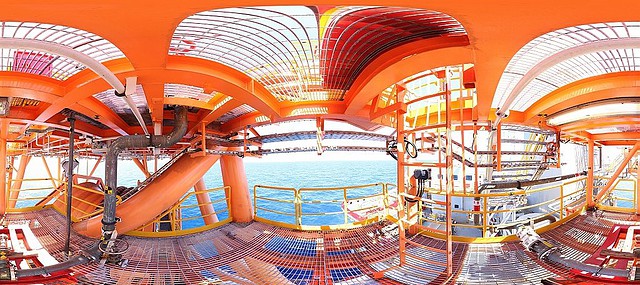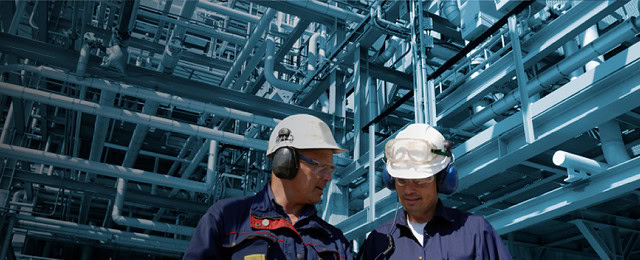360-degree panoramic photography is a technique that captures the entire surrounding environment in a single image, offering viewers an all-encompassing and immersive visual experience. This photographic method involves using specialised cameras or stitching multiple images together to create a seamless, spherical view. The result is a dynamic image that allows users to explore a scene in its entirety, horizontally and vertically, as if standing at the center of the captured space. This format is particularly popular in virtual reality (VR) and online platforms, where viewers can interactively navigate the panoramic image, transforming it from a static photograph into a gateway for virtual exploration.
Panoramic photography is a powerful tool, serving as a cornerstone in the creation of digital twins—a virtual representation of physical spaces or objects. This page explores the multifaceted role of panoramic photography, examining its applications in asset management, virtual tours, and the creation of immersive digital twins.
Virtual Tours and Panoramic Photography
Virtual tours are a natural extension of 360-degree panoramic photography, providing users with an unparalleled and immersive exploration of spaces. By leveraging this technique, virtual tours transcend the limitations of traditional static images, offering a dynamic and interactive experience. Viewers can navigate through a scene in all directions, horizontally and vertically, gaining a comprehensive understanding of the environment as if physically present. Whether used for site orientation, in maintenance training to educate operatives before visiting the site, or to enabling engineering teams to explore sites in great detail from the office, 360-degree panoramic photography breathes life into virtual tours. The result is an engaging and realistic experience that not only informs but also captivates audiences, creating a bridge between the digital and physical worlds.

Creating Immersive Digital Twins
In the dynamic landscape of engineering and construction, 360-degree panoramic photography emerges as a pivotal tool for enriching the creation and management of digital twins. By capturing a comprehensive view of construction sites, buildings, or infrastructure projects, 360-degree photography contributes to a more immersive and detailed representation within the digital twin framework. Construction professionals leverage this technique to document project progress, creating a visual timeline that allows stakeholders to remotely inspect sites at various stages of development. This not only facilitates efficient communication among project teams but also serves as a valuable historical record for future reference.
The use of 360-degree panoramic photography in engineering and construction digital twins goes beyond static images, providing a dynamic and interactive means of site documentation. Project managers and stakeholders can virtually navigate through spaces, gaining insights into spatial relationships, structural details, and construction phases. This aids in the identification of potential issues, streamlines decision-making processes, and ensures that the digital twin remains a true reflection of the physical site. Additionally, the integration of 360-degree panoramic imagery enhances communication with clients, investors, and regulatory authorities, offering a more transparent and engaging way to showcase project developments.
Panoramic Photography in Asset Management
Asset management is a critical aspect of industries ranging from facilities management to manufacturing, and panoramic photography plays a pivotal role in streamlining this process. By employing panoramic imaging techniques, asset managers can capture comprehensive visual documentation of physical assets. This visual data, when integrated into a digital twin, becomes a dynamic repository of information about the asset. For example, in facility management, panoramic photography can create immersive digital twins providing a holistic view of spaces, enabling remote inspections, facilitating efficient documentation, and fostering better decision-making for maintenance and operational purposes. In manufacturing, assets such as machinery or equipment can be documented through panoramic photography, enabling maintenance teams to conduct virtual inspections and assessments.

Technology Enablers and Advances
The seamless integration of panoramic photography into the digital twin landscape is made possible by technological advancements. High-resolution cameras and sophisticated stitching algorithms ensure that panoramic images are not only visually stunning but also accurately represent the details of the physical environment. In addition, the rise of virtual reality (VR) and augmented reality (AR) technologies has further elevated the impact of panoramic digital twins. Users equipped with VR headsets can experience an even more immersive exploration, feeling as though they are physically present in the digital twin. AR applications enable the overlay of digital information onto the real-world environment, enhancing the utility of panoramic digital twins in fields like maintenance and training.
Applications Across Industries
Panoramic photography’s integration into digital twin technology has found applications across diverse industries. In real estate, virtual property tours created through panoramic imaging contribute to more informed decision-making by allowing prospective buyers to virtually explore homes. For facilities management, panoramic digital twins enable remote inspections and assessments, reducing the need for physical presence on-site. In cultural heritage preservation, panoramic digital twins serve as interactive archives, allowing users to virtually wander through historical sites and artifacts. Industrial applications range from virtual walkthroughs of manufacturing facilities to training simulations for complex machinery operation.

Future Trends and Evolving Landscape
Looking ahead, the future of panoramic photography in the context of digital twins holds exciting possibilities. Continued advancements in camera technology, including the integration of depth-sensing capabilities, will enhance the realism and interactivity of panoramic digital twins. The convergence of panoramic imaging with 3D scanning technologies may enable the creation of even more detailed and immersive representations. As the adoption of VR and AR technologies continues to grow, the demand for panoramic digital twins is likely to increase, driving further innovation in how we visualize and interact with virtual environments.
Conclusion
In conclusion, panoramic photography has evolved from capturing expansive landscapes to becoming a fundamental component in the creation of immersive digital twins. Its applications in asset management, virtual tours, and beyond are reshaping how industries approach visualization and documentation. The fusion of panoramic photography and digital twin technology unlocks new possibilities for remote exploration, informed decision-making, and interactive experiences. As technology continues to advance, panoramic digital twins are poised to play an increasingly integral role in diverse sectors, offering a bridge between the physical and virtual worlds.
